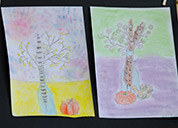Papier Mâché African Animal Masks
Develop masks of intricate and detailed animal characters using simple materials.
SCHOOL: Blue Heron Middle School
TEACHING ARTIST: Martha Worthley
GRADE: 6 (can be adapted to any grade)
Lesson: Students construct a large-scale African animal character mask using papier mâché. Colors, patterns and textures inspired by African art are then added to convey character. This project takes place over at least five days of 1-2 hour sessions.

Student:
Target learning: Creates a three-dimensional mask in the form of an animal head.
Criteria: Builds a mask using the shape of an animal head on a piece of corrugated cardboard that renders the brow or forehead, eyes, ears, nose (trunk, snout, tusks) mouth in fully rounded form.
OR uses wadded newspaper to create a 3-D form (animal’s head) on a flat piece of cardboard
Target learning: Uses color and surface decoration influenced by African traditions
Criteria: Divides the face into distinct areas to receive different color treatment: uses stripes , dots, or other geometric patterns to emphasize the animal’s features. Adds embellishment as part of the surface decoration
Target learning: Animal mask conveys character.
Criteria: Chooses and applies color, pattern, and texture is to communicate the animal’s personality.
Resources introduced and creative process
Students are first asked to draw their animal in charcoal, looking at photographs and graphic pictures of the animal. They then view images of African masks. Surface pattern and decoration are discussed, along with color, different styles presented, and simplification of form
Vocabulary (click here for the glossary)
three dimensional
surface decoration
simplified form
geometric pattern
contour
Resources
slide show of African masks
actual masks from Africa if available
lots of graphic images of animals
student charcoal drawings of animals
Materials
recycled corrugated cardboard
recycled newspapers
masking tape
lightweight white paper cellulose tempera paint
white glue
hot glue
hot glue guns
shells, beads, raffia yarn, sequins, glitter
6th grade Language Arts/Social Studies research includes learning about the average size and weight of the adult animal, which region of Africa it inhabits, what its offspring are called, common foods eaten, desired habitat. For developing a folk tale, students are then asked to choose characteristics for their animal that will be key elements of their story. The masks are intended for use in performance of a folk-tale the student has written.
Teaching artist:
Day one:
Using a charcoal drawing of an animal and other graphic images, plus knowledge of African mask forms, discusses how to decide the basic shape of the mask. Discusses which features of the animal’s head will protrude, in what direction? What is the best shape to start with? Think of the example of the zebra and giraffe masks, where the shape you see is from the top of the head to the end of the nose, for example. Creates a cardboard silhouette on which to build the form of the mask.
Day two:
Demonstrates rolling the newspaper into padded newspaper “dumplings.” These basic building blocks have one smooth side and retain their shape. They are taped to the cardboard with masking tape. Dumplings are added on top of dumplings, increasing the volume of the form being created. Demonstrates rolling tubes and other forms out of newspaper to make different shapes. Uses extra cardboard for ears, trunks, noses, etc.
Day three:
When the student has achieved an accurate three-dimensional form with the newspaper, the “skin” or papier mache layer covers the form. White paper is smeared with a mixture of cellulose fiber and water that makes a paste. The paper is torn into strips and applied over the newspaper. Attention is paid to creating a smooth, contoured surface. The white paper must cover the front and the back so that the mask becomes a strong, secure object.
Day four:
The next step is painting the form using ideas from the African masks such as divided areas of color, exaggerated pattern, etc.
Day five:
The final step includes using hot glue and white glue to add embellishments such as shells and beads, feathers, yarn, raffia and any other material the student discovers to enhance the surface decoration.
Assessment
Criteria-based self assessment
Essential learnings:
Arts 1.1 concepts: shape, 3-D form, pattern, character
Arts 1.2 skills and techniques: papier mâché sculpture
Arts 4.4 Arts reflect culture and history
